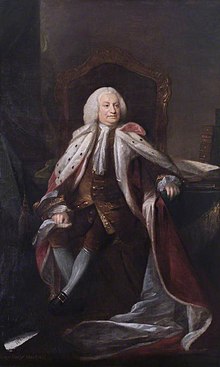George Parker, 2nd Earl of Macclesfield
The Earl of Macclesfield | |
|---|---|
 Portrait by Benjamin Wilson | |
| 15th President of the Royal Society | |
| In office 1752–1764 | |
| Preceded by | Martin Folkes |
| Succeeded by | James Douglas |
| Teller of the Exchequer | |
| In office 1719–1763 | |
| Preceded by | The Lord Torrington |
| Succeeded by | George Grenville |
| Personal details | |
| Died | 17 March 1764 |
| Children | 2 |

George Parker, 2nd Earl of Macclesfield, FRS (c. 1697 – 17 March 1764) was an English peer and astronomer.
Biography[edit]
George was tutored by Welsh mathematician William Jones,[2] who went on to become the first person to use the symbol π (the Greek letter Pi) to represent the ratio of the circumference of a circle to its diameter.
Styled Viscount Parker from 1721 to 1732, he was Member of Parliament (MP) for Wallingford from 1722 to 1727, but his interests were not in politics. In 1722, he became a fellow of the Royal Society, and he spent most of his time in astronomical observations at his Oxfordshire seat, Shirburn Castle, which had been bought by his father in 1716; here he built an observatory and a chemical laboratory.
He was very prominent in making the case in Parliament for the Calendar (New Style) Act 1750, with which the Kingdom of Great Britain and the British Empire changed from the Julian calendar to the Gregorian calendar in 1752.
When his son ran for parliament as a Whig in 1754, his role in the calendar reform was one of many issues raised by the son's Tory opponents; one of Hogarth's satirical series of paintings about these elections (1755) is the only source for the subsequent "Give us our eleven days" myth.
From 1752 until his death, Macclesfield was president of the Royal Society, and he made some observations on the great 1755 Lisbon earthquake.
In 1750, Macclesfield was offered the honorary position of vice president of the Foundling Hospital,[3] which he accepted and kept until his death in 1764. The Foundling Hospital was a charitable institution created a decade earlier, dedicated to saving London's abandoned children. The Earl seems to have taken his position seriously, as he commissioned the artist Benjamin Wilson to paint a full-size portrait of him, which he then donated to the hospital. The portrait is still in the Foundling Hospital Collection and available to view at the Foundling Museum.
In 1755, Parker was elected a foreign member of the Royal Swedish Academy of Sciences. He also was a corresponding member of the Académie des sciences.[4]
Family[edit]
George Parker was born in about 1697 to Thomas Parker, 1st Earl of Macclesfield and his wife Janet née Carrier.[5] George Parker married twice. Firstly, on 18 September 1722 to Mary Lane daughter of Ralph Lane, Turkey merchant, of Woodbury; with issue:[citation needed]
Secondly, on 20 December 1757 at St James Westminster, to Dorothy Nesbitt, with no known issue
See also[edit]
References[edit]
- ^ Debrett's Peerage, 1968, p. 723
- ^ "Macclesfield Collection". Cambridge Digital Library. University of Cambridge. Retrieved 8 January 2024.
- ^ Nichols, R.H.; Wray, F A. (1935). The History of the Foundling Hospital. Oxford University Press. p. 32.
- ^ Hill, Elisabeth (1961). Whyte, Lancelot Law (ed.). "Roger Boscovich: A biographical essay". Roger Joseph Boscovich, S.J., F.R.S., 1711-1787: Studies of His Life and Work on the 250th Anniversary of His Birth: 41. Retrieved 30 January 2012.
- ^ This article incorporates text from a publication now in the public domain: Chisholm, Hugh, ed. (1911). "Macclesfield, Charles Gerard, 1st Earl of". Encyclopædia Britannica. Vol. 17 (11th ed.). Cambridge University Press. pp. 202–203.
`
- 1690s births
- 1764 deaths
- 18th-century British astronomers
- British MPs 1722–1727
- Fellows of the Royal Society
- Members of the Prussian Academy of Sciences
- Members of the French Academy of Sciences
- Members of the Parliament of Great Britain for English constituencies
- Presidents of the Royal Society
- Members of the Royal Swedish Academy of Sciences
- Parker family
- Freemasons of the Premier Grand Lodge of England
- Earls of Macclesfield
